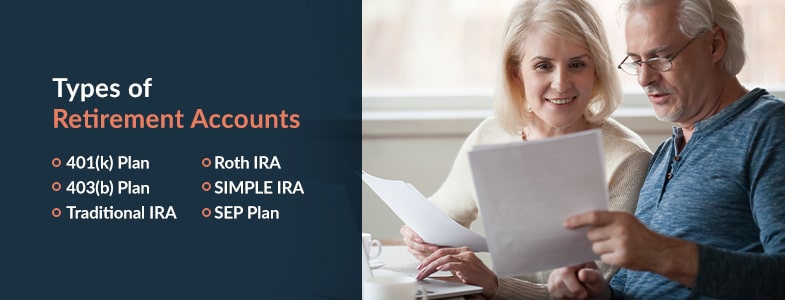
Types of Retirement Accounts: What You Need to Know
Saving for retirement can seem daunting, but knowing which types of retirement plans align best with your savings and retirement goals relieves stress and encourages peace of mind. If you are in the midst of retirement planning, you may be asking yourself —which retirement account is best for me?
This guide will help you understand the various retirement account types and the benefits of each retirement account. Saving for retirement can be a simple process when you are informed and have clear savings goals. At HSC Wealth Advisors, our financial services can help you plan for your future.

What Are the Different Types of Retirement Accounts?
There are several retirement account types available, including traditional and non-traditional options. Individual retirement accounts like 401(k)s and IRAs may fall under the umbrella of traditional retirement plans, while non-traditional options include plans like Roth IRAs. In addition to a 401(k), some employers offer 403(b) retirement options. The key difference between retirement accounts that are traditional or non-traditional is when you pay taxes on the funds.
1. 401(k) Plan
A 401(k) is a work retirement plan that employers offer their employees. With a traditional 401(k), you can contribute your pre-tax dollars to the account. This means you can reduce your taxable income if you make pre-tax contributions. The contribution limit for a 401(k) plan is $19,500. If you are age 50 or older, you can contribute another $6,500 to the account. The benefits of a 401(k) include:
- Employer match: Though this varies by employer, some employers offer a company match. This means your employer will match your contribution up to a certain percentage, so your money will grow even faster.
- Automated saving: Your contribution to your 401(k) will be deducted from your paycheck. Since the savings process is automated for you, you will not have to worry about forgetting to make your contribution each month or pay period.
- Tax-deferred growth: The money in your 401(k) will grow tax-deferred. Your employer may also allow you to make after-tax contributions to your 401(k).
- High contribution limit: Compared to other retirement account types like IRAs, the contribution limit for a 401(k) is much higher.
If your employer offers a 401(k) and you want to put your savings for retirement on autopilot, this plan can be a great option.
Before you begin contributing, however, make sure you determine whether there are fees associated with the account, such as an account maintenance fee. Though your money will grow tax-deferred, during retirement, you will pay taxes when you make withdrawals. Additionally, since your employer sets up the plan, you can only select from the investment options provided. You may need to pay a penalty for an early withdrawal.
2. 403(b) Plan
A 403(b) plan is a retirement plan that is also known as a TSA plan, or a tax-sheltered annuity. A 403(b) is offered to public school employees and employees of other qualifying organizations, including churches and charitable entities that are tax-exempt according to Section 501(c)(3). If your employer offers a 403(b) plan, you and your employer can contribute to this individual account to help you save for retirement.
Like a 401(k), the contribution limit for a 403(b) plan is $19,500. If you are at least 50 years old, you can contribute an additional $6,500. The limit on the total that both you and your employer can contribute is typically $58,000 or 100% of includable compensation, whichever is less. The advantages of a 403(b) plan include:
- Matching contributions: As with a 401(k), you may be eligible for matching contributions from your employer.
- Tax-deferred growth: Until you make withdrawals, your earnings and returns are tax-deferred.
- Lower fees: A 403(b) plan tends to have lower administrative fees than a 401(k) plan.
If you want to withdraw funds before you are 59 1/2, you will usually need to pay a tax penalty. However, there are some exceptions, such as becoming disabled or needing to pay a qualifying medical expense. Your investment options may also be limited with a 403(b).
3. Traditional IRA
A traditional individual retirement account is managed by you, the individual policyholder. When you choose an IRA, you open the account and fund it yourself rather than joining through an employer.
Depending on your access to other retirement plans through your employment and your income, you may receive a tax deduction on your contributions to a traditional IRA. Your balance will grow tax-deferred, though your withdrawals will be taxed. The current contribution limit is $6,000, or $7,000 if you are at least 50 years old. If you make less than this amount, the limit is your taxable yearly compensation. Benefits of a traditional IRA include:
- No income limits: There are no income limits for a traditional IRA, so if you make too much money to contribute to other plans, you can still contribute to a traditional IRA.
- Tax-deferred growth: Since your money is growing tax-deferred, this can also be a great financial benefit over the long term.
- Lower tax bill: If you are eligible for deductible contributions, you may be able to use a traditional IRA to lower your tax bill.
- Consolidate and roll over 401(k): If you have a 401(k) from a previous job, you can use a traditional IRA to consolidate and roll over the amount from your 401(k).
Traditional IRAs have some restrictions, such as the contribution limit and when you can make withdrawals without paying a penalty. If you withdraw funds prior to age 59 1/2, you will pay a 10% penalty. You also may have to begin taking withdrawals from your IRA at age 70 1/2 if you were born prior to July 1, 1949, and at age 72 if you were born after June 30, 1949.
4. Roth IRA
Another individual retirement account option is a Roth IRA. As the individual policyholder, you will manage this account, not your employer. Your contributions to a Roth IRA will be made with after-tax money, meaning you will not receive a tax deduction for your contributions. However, you can withdraw the money tax-free when you reach retirement and the balance will grow tax-free.
As with a traditional IRA, the current contribution limit is $6,000 or $7,000 if you are at least 50 years old, though if you make less than this amount, the contribution limit is your taxable yearly compensation. Benefits of a Roth IRA include:
- Tax-free growth: Though the contributions you make to a Roth IRA will not lower your current tax bill, your money will grow tax-free.
- Tax-free withdrawals: You can enjoy more value down the road when you can withdraw your money tax-free.
- No minimum withdrawals: Unlike some other retirement accounts, you can leave funds in a Roth IRA for your entire life.
- Contributions permitted after age 70 1/2: Unlike some other retirement plans, you can continue making contributions to a Roth IRA after reaching age 70 1/2.
If you want to withdraw from an account in retirement without needing to pay taxes, a Roth IRA can be a great option. If you are in a low-income tax bracket and anticipate being in a higher tax bracket when you reach retirement, you may also want to choose a Roth IRA. Even if you have a retirement plan through your job, you can still contribute to a Roth IRA.
If you take certain distributions prior to age 59 1/2, you will pay a penalty. There are also income limits that may prevent you from being eligible to contribute to a Roth IRA.
5. SIMPLE IRA
A Savings Incentive Match Plan for Employees (SIMPLE) IRA is a retirement plan that is established by your employer. Your employer will contribute to this plan on your behalf, and you are not required to make contributions. Only small employers with no more than 100 employees can offer SIMPLE IRAs. The contribution limit is $13,500 or $16,500 if you are at least 50. The pros of a SIMPLE IRA include:
- Tax-deferred growth: If you choose to contribute to your SIMPLE IRA, your contributions will be made with pre-tax dollars. Your funds will grow tax-deferred, which means you will instead pay taxes later when you make withdrawals in retirement.
- Free money: Your employer will contribute to your SIMPLE IRA at 2% of your salary, regardless of whether you make contributions yourself.
- Matching contribution: If you make contributions to your SIMPLE IRA, your employer can match up to 3%.
Compared to a 401(k), the contribution limit is lower and the penalty for an early withdrawal is higher at 25%.
6. SEP Plan
A Simplified Employee Pension (SEP) plan is a retirement account that a self-employed individual or a small business owner establishes for themselves and any employees. When you make withdrawals during retirement, you will pay taxes on these withdrawals. The current contribution limit of a SEP plan is either $58,000 or 25% of your earned income, whichever is lower. Benefits of these plans include:
- Higher contribution limit: Compared to IRAs, the contribution limit is higher for a SEP plan, meaning you can save more each year for retirement when you have a SEP.
- Reduce taxable income: If you make contributions to a SEP plan, you will reduce your taxable income. If you are a small business owner, your contributions will be tax-deductible. Your funds in a SEP plan will grow tax-deferred.
If you are an employee whose employer offers a SEP plan, only your employer can make contributions. If you are a small business owner looking to set up a SEP, there are some unique rules to follow and more paperwork to complete, and you may want to consult a tax advisor.
Retirement Planning Best Practices
The goal of retirement planning is to never run out of money. Of course, this can be easier said than done, especially for those who are hesitant to take the risks needed to grow a reliable nest egg. To help ensure you can save for your ideal retirement, utilize the retirement planning best practices outlined below and avoid common retirement mistakes.

1. Start Saving for Retirement Early
The best time to start saving and planning for retirement is now. The earlier you start, the more time your savings will have to grow. When you invest early and stay invested, you can take advantage of compound interest—meaning your money will make you more money.
The later you start, the more you will need to save each month to reach the same retirement goal. If you are particularly limited in how much you can contribute each month, waiting too long may mean you are not able to reach your savings goal by the time you reach retirement age.
2. Diversify Funds
Diversifying your investments is essential for mitigating risk and building a large nest egg. You may choose to invest in popular assets like stocks, bonds, ETFs and mutual funds, along with alternative investments like real estate and precious metals. Diversifying funds can offer the following benefits:
- Keep your capital safer
- Reduce the effect of market volatility
- Reach your long-term retirement savings goal
- Enjoy the advantages of different investment types
- Reduce the time you spend monitoring your portfolio
- Shuffle your investments to take advantage of movement in the market
To properly diversify your retirement portfolio, invest in multiple sectors. When you invest in multiple sectors, you are avoiding the risk of having all your money in a single sector. You may also want to choose a flexible retirement plan so you will not be limited by what an employer selects and can choose to invest in both traditional and alternative investments.

3. Hire a Financial Advisor
One of the best things you can do for your retirement planning is to get educated. Unless financial planning is your job, you may not have time to learn everything you can about creating a plan for your financial future. In this case, you may want to hire a financial advisor, also known as a financial planner, who can help you identify the retirement contribution plans that may be right for you.
A financial advisor can recommend certain investment vehicles and products and draw up retirement savings plans. If you choose to hire a financial advisor, they will meet with you to discuss your financial goals and assess your current financial circumstances. A financial advisor can also set up investment accounts and invest money on your behalf.
Contact HSC Wealth Advisors
At HSC Wealth Advisors, we use a client-centered approach to assure we keep your best interests in mind when we offer retirement investment advice. Unlike the brokerages that utilize product-focused sales tactics, our fee-only, independent service can address your comprehensive financial goals. Our IRA and 401k advisors near Lynchburg, VA can help diversify your retirement portfolio. We use ETFs and no-load, no-transaction-fee mutual funds, and have been serving clients in Virginia and other states for more than 30 years.
If you are interested in saving for retirement, contact us at HSC Wealth Advisors to demystify the seemingly complicated process of making a retirement plan.
Justin is a CERTIFIED FINANCIAL PLANNER professional and a NAPFA-Registered Financial Advisor. He earned a BS in Finance from Liberty University and completed University of Georgia – Terry College of Business' Executive Program in Financial Planning.


